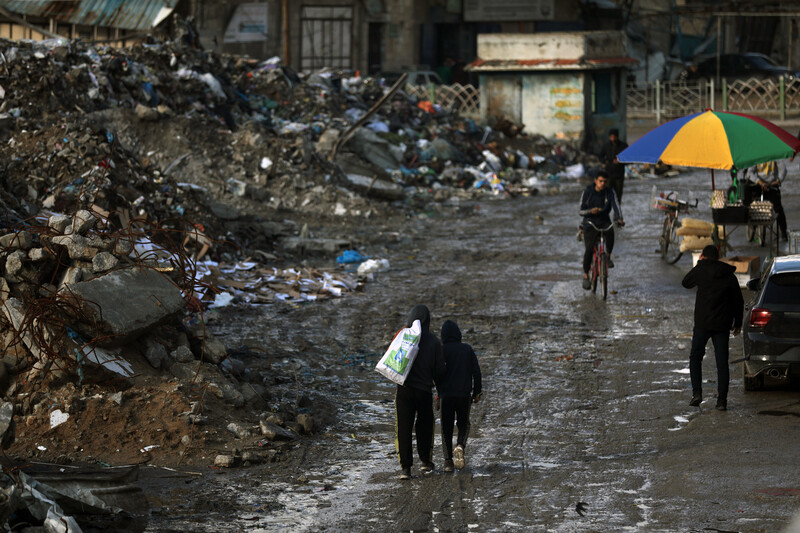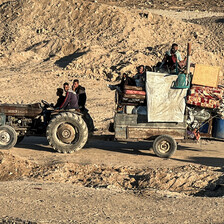The Electronic Intifada 24 May 2025

Trash piles up on every corner, rotting under the sun, releasing a stench that clings to the air.
ActiveStillsBefore the genocide, walking through Gaza was an act of freedom, a simple pleasure that brought a sense of peace.
The streets were alive – filled with movement, laughter and conversation. I knew every road by heart, every corner felt familiar. I walked without fear of getting lost: the streets of Gaza always led me home.
Now, walking is no longer healing – it is suffering. The same roads that once carried the footsteps of students, workers and families are now buried beneath rubble. The places I used to pass daily – shops, schools, homes – have vanished. What remains is a landscape of ruins, unrecognizable and suffocating.
Walking through Gaza is no longer the warm embrace of familiarity but a confrontation with loss.
The roads are not just filled with debris from destroyed buildings, they have become dumping grounds for uncollected waste. Gaza’s municipal services have collapsed. Garbage trucks that once kept the streets clean have been destroyed or rendered immobile due to the lack of fuel.
Trash piles up on every corner, rotting under the sun, releasing a stench that clings to the air. Swarms of mosquitoes rise from the waste, carrying disease to a population already suffering from starvation and malnutrition. The spread of infections is relentless, yet there is no medicine, no relief, no way to stop the cycle of sickness.
Before, I would walk these streets and see workers sweeping the roads in front of their shops, and children running past with school bags bouncing on their backs. Now, I walk carefully, stepping over heaps of filth, over fragments of what once was a thriving city.
The people of Gaza, already exhausted from hunger and war, are forced to navigate this decaying landscape, their bodies growing weaker with each passing day.
Black soles
As I walk, I notice the feet of those around me. Many are walking barefoot — their feet tell stories of suffering, their soles blackened by dirt.
Those who still have shoes wear them until they are nothing but thin layers of fabric, barely holding together. The luxury of new footwear no longer exists; people wear what they have until it falls apart.
Walking through Gaza now is a painful experience, not just emotionally but physically. Each step is a battle against exhaustion, hunger and injury. The roads are filled with people moving slowly, their bodies too weak to walk with the same energy they once had. In their eyes, I see the toll of survival.
I pass by a tikiyeh, a charity kitchen, where children stand in endless lines, waiting for any small portion of food. These are the same children who once ran to school in the mornings, laughing and playing with friends. Here, they stand in silence, their bodies frail, their eyes hollow.
Hunger has stolen their childhood, replacing it with an existence defined by waiting – waiting for food, waiting for water, waiting for an end to their suffering.
Further down the road, another line stretches toward a water station. With no fuel to operate pumps, clean water is scarce. People carry empty bottles, jugs, and buckets, hoping to fill them with whatever they can find.
Families ration water carefully, knowing that they may not get another chance to refill. Gaza’s thirst is not just for water but for dignity—for the right to live without begging for the most necessities.
Still standing
Among the destruction, I see some houses that are still standing, but only partly. The walls are cracked, roofs caved in and windows shattered.
Families who have nowhere else to go try to make their broken homes livable again. They hang fabric and old clothes over gaping holes in the walls, desperate for some privacy, for some sense of shelter. These makeshift coverings flap in the wind, a fragile barrier against the outside world.
Before, these homes were places of warmth, filled with the smells of home-cooked meals, the sound of children’s play and the comfort of family gatherings. Now, they are cold and broken, their residents living in fear of another strike that will bring the walls crumbling down completely.
As I continue walking, my path leads me toward the Egyptian-Palestinian border in Rafah. It is a gate that once symbolized a connection to the outside world, a passage to safety. Now, it is a dead end. Sealed by Israeli orders, the border traps 2.5 million people inside an open-air prison.
There is no medicine, no food, and no essential supplies allowed in since Israel took control of Rafah crossing in early May 2024.
The sick who need urgent medical treatment are denied the right to leave. Students who earn scholarships abroad find their dreams slipping away. Families who have already lost everything are told they cannot even seek refuge beyond these borders.
This is collective punishment: a deliberate act of cruelty that leaves an entire population struggling to survive.
Before, I never thought about the border. I didn’t need to. Life in Gaza was difficult, but there was movement and possibility. Now, every step I take reminds me that we are trapped. The streets do not lead to freedom; they lead only to more suffering.
Still walking
The ceasefire was nothing but an illusion. The bombs may have paused for a moment, but the suffering never ceased.
The streets remain filled with destruction, the markets with empty shelves, and the hospitals with patients who cannot be treated.
Those who fled south seeking safety returned to find nothing but the same tents, the same hunger, the same desperation.
Even when aid trucks are allowed in, prices are impossibly high—how can people who have not worked for over a year afford food that now costs double?
There is no rebuilding, no healing, no return to normalcy. The ceasefire was never meant to bring peace; it was merely a brief inhale before the next strike.
Now, as the genocide has resumed in full force, once again, people wander the streets aimlessly. But this time, they do not fear death. They fear life, a life that is no longer a life, but a relentless descent into hell.
Yet, they walk. There are no cars, no buses, no fuel, only the will to keep moving.
Women in their traditional prayer clothes walk with faces marked by grief, but they still smile.
Children carry jugs of water on frail shoulders, their feet covered in dust, yet they press forward.
I see men who have lost everything – families, homes, livelihoods – continue to put one foot in front of the other.
Before the genocide, walking was an act of healing. Now, it is a confrontation with pain.
But as long as Gaza walks, it refuses to fall. Even through the ruins, Gaza walks on. And as long as we walk, we are still here.
Asmaa Abdu is a project coordinator with Sameer Project, a humanitarian relief organisation.





